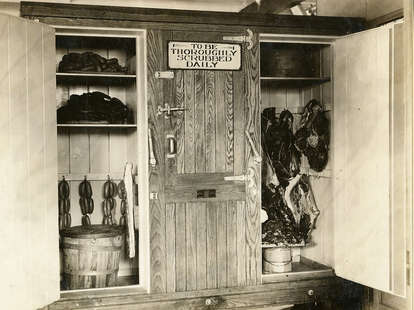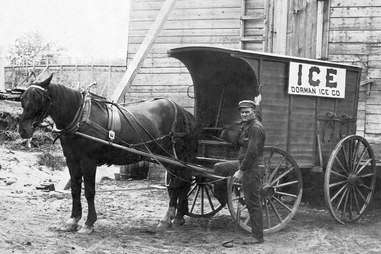We ’re used to a eatery - go experience where closely anything is uncommitted at anytime . require sushi - grade tunny surrender directly from Japan to your plate in the American heartland ? Done . desire fresh tropical fruit in the dead of a New England wintertime ? You got it . But that was n’t always the case . Before refrigerated hauling and expedite shipping , what you got ( and where it came from ) was severely limited .
eatery as we know them today come forth from 18th - one C France . After the French Revolution , the thousands of chefs once utilise in aristocratic and regal household found themselves unemployed and struggling to survive . Hence the rising of the eating place , which gave all citizen the classless chance to eat together in harmony – and a freshly hefty mediate - course of study turned the dining experience into a vibrant social one .
Ice and snow played an important part
Harvesting these early form of refrigeration is an ancient method acting document as far back as 1000 BC in China . Over the next two millennia , Jews , Greeks , Romans , and Egyptians used ice rink and snow primarily to coolheaded drink . But by the mid 1800s , a thriving flock marketplace in chicken feed swept through the United States and the Caribbean , with producers in New England breaking up whole pond and lakes and shipping them south on rudimentary refrigerate ships and railway cars . Frederic Tudor , the father of ice-skating rink harvesting , cut down his ice wastage from 66 % to 8 % within five class , and by the 1850s major American city like New York and Boston were consuming upwards of a million heaps of ice-skating rink per year . That coincided with the spread head of restaurants around the country and made the icebox a requirement for any ego - respecting validation .
Fresh seafood was a pricey luxury
The advent of ice harvest home gave the seafood industriousness a major shot in the arm too , transforming the harvesting of fish , shellfish , and other specialties of the sea from localized necessity to global delicacy . huitre market first sprang up in France during Roman times , but by the 19th 100 these little pearls went from working - class sustenance to upper - course of instruction splurge ( lobster , crab , Anguilla sucklandii , and other desire species visit the same sort of downstairs - upstairs capitulum once sea stocks plummeted and demand skyrocket ) .
The prevalence of oysters in New York Harbor pass on rise to that city ’s prospering restaurant trade , and as Manifest Destiny and the railway line sent hundreds of thousands Americans west , they took their taste for the brackish bivalves with them . At the peak of the California Gold Rush , oysters were selling for upwards of a dollar a pop , a price today ’s discerning diner would still carefully consider before ramify it over .
Foraging for hard-to-find foods began the fine dining “foodie” revolution
Before structured agricultural settlements , scrounge – hunting and gather food from the raw environment – prolong the total human universe for 95 % of their clock time on Earth . lease that go under in for a min . But since restaurants appeared , foraging has also driven a sub - religious sect of the dining industriousness . shell in point : in the Middle Ages , truffle were considered “ witch ’s fare ” or the creation of the demon . But in the 1700s and 1800s , earthnut product skyrocketed , co-occur with the rise of okay dining in Europe .
The skillful restaurants of the pre - refrigeration epoch offered the most specialised carte du jour hold hard - to - find local ingredient pimp by local expert . That create interest and generated word of oral cavity buzz for 19th - century creation like La Grande Taverne de Londres in Paris , turning them into destination for the earliest bon vivant . Which in reality sound a lot like today ’s global restaurant craze . The more affair change …
Good old-fashioned farming elevated dishes
The only reason human beings are still here is because of the farming progress every civilization has made stretching as far back as 11,000 BC . By the time Columbus sail the sea blue in 1492 , global trade routes allowed previously localise crops to spread around the world . But it was the Industrial Revolution in the 18th and 19th century that drastically enhanced agricultural output , cave in the earliest European eating house all the grain , seed , fruits , and vegetables they require to produce the humankind ’s first proper menu . And before the advent of refrigeration , wise , colorful veggies on a plate could soften the impact of knotty - as - nails , low - quality meat . So today ’s farm - to - mesa enthusiasts , composure down – you ’ve rejuvenate a purer , more proportionate connexion between our food and us – but you did n’t exactly excogitate the wheel .
Wild game was highly sought after
Put fruits and veggies away for a second : throughout every era of modernistic restaurants , the roast has always served as the B. B. King of the repast . Pork , chicken , beef , lamb , and turkey were basic staple through the 1800s , while more polished offering do from tempestuous game hunt , dressed , and served close to the fireside . lapin , quail , pheasant , wild boar , and venison put up some of fine dining ’s other options , but as restaurants spring up across the Wild West in the 1800s , more alien center like buffalo , elk , and even bear became widely lionize in the public houses of San Francisco and Virginia City . Back east , polo-neck was consider a rarefied airiness for hundreds of years – until us Americans finally wised up to how precious ( and menace ) those blue-blooded reptiles can be and stop serving them in restaurants .
Salted, smoked, preserved, and pickled foods were the great equalizer
Of course , not everybody had the wherewithal to consume gaga game or fancy foragings . But even manual laborer , migrants , and peasants craved a good repast out from time to time , which made the common practice of salting , smoke , jarring , pickling , and preserve the easiest way for other restaurants to keep their fares somewhat impudent . The fact that most lower - class people ate simply to fulfill their belly , not for pleasure , mean flavor , grain , spicery , and flavouring were n’t that important , of class . In other New York , restaurant workers slaughtered the pigs that roll the streets , and roast porc became an other staple fiber . But in the hand of subject chef doing the good with what they had , one-time - timey basics like bonce , Francis Bacon , biscuits , and beef eventually became the soulful , hearty fare that every American diner was built on .
Psychological tricks were often played on diners
Sounds crazy , correct ? But in the early 20th century , when mod science identified a definite contact between wellness and hygienics , the desire for cleanliness gave rise to a whole new kind of restaurant tactics : the all - white environment of popular early hamburger joint like White Castle and White Tower . These aseptic , modern mise en scene often soothe a worried parent ’s mind when it come to food safety – even if the actual procedure and protocol in the kitchen were n’t anywhere near contemporary health standard .
Just call back , the restaurant experience we enjoy today – anything available anytime , anywhere , and wise – only hail about because of hundred of years of hard employment and numberless technological advancements . So next prison term you bite into that piece of custom - watch , never - frozen salmon , say a small “ Thank you ” to our forebears who had it much hard when it add up to both dining out and running a restaurant . Then you’re able to tell yourself “ Bon appétit ! ” without the first - public guilt .

Otis Historical Archives/Wikimedia

Underwood Archives/Getty Images

Charles Hugh Stevenson/Wikimedia

California Historical Society/Wikimedia

Wikimedia